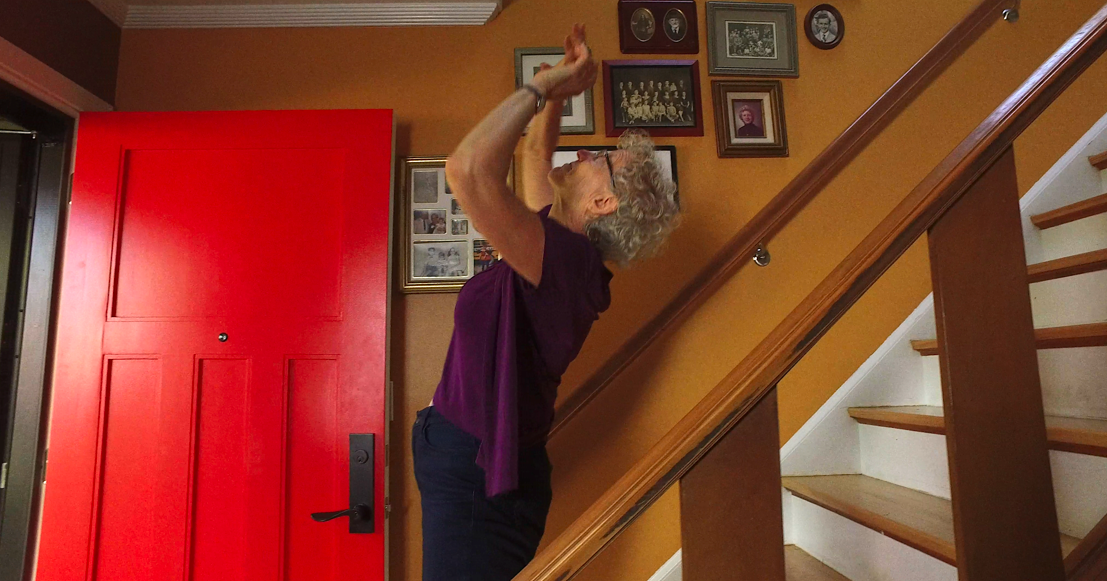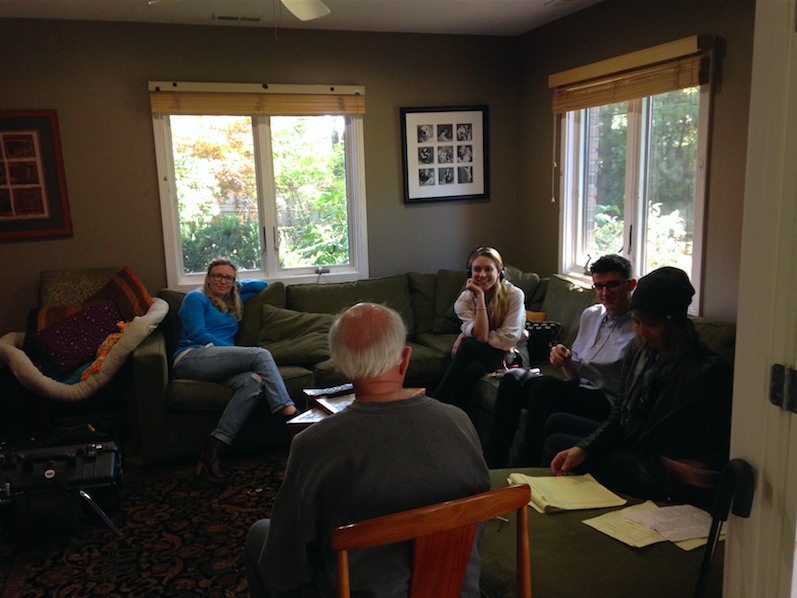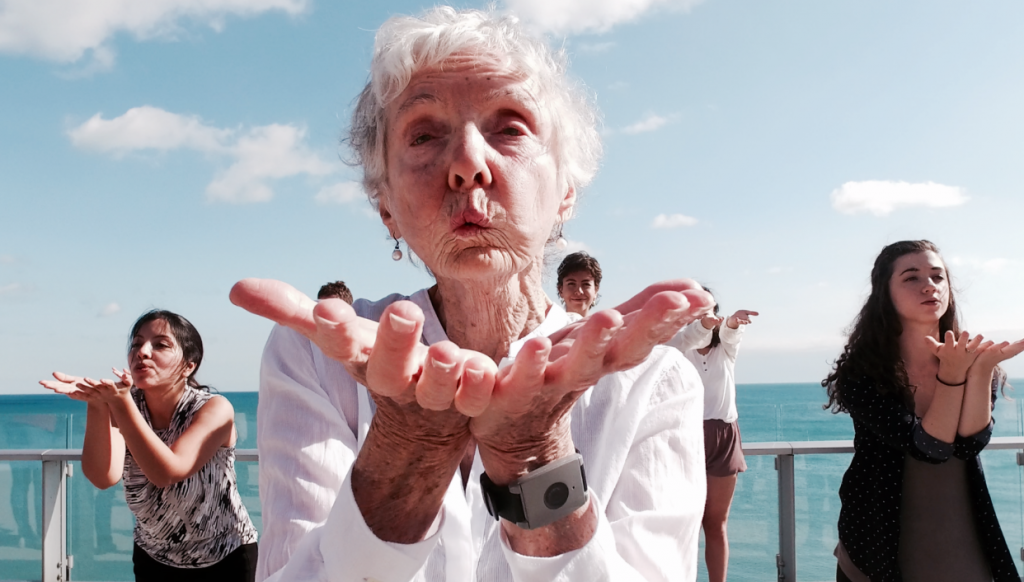Outside the fourth floor balcony of the Information Commons (IC), a group of nearly 25 people — some old and some young — gathered in a clump. Slowly they inhaled, collectively staring up to the bright, blue sky and proceeded to perform the movements that for some are new, and for others have been rehearsed for months. A couple with a tiny camera weaved through the group, capturing both the individual and the collective movement for what was soon to become “All,” a dance film about forming community in places and with people we wouldn’t normally associate with.
Loyola faculty, students, alumna and community dancers with Parkinson’s Disease came together last semester to form the Virtual Dance Ensemble, a project centered around creating a dance film using the medium to bring dancers from different communities together. The project’s inception began at Loyola’s In/Motion Dance Film Festival in 2015, came to fruition during filming last October and will come full circle March 17-19, when the completed film, “All,” will screen for the first time at Loyola’s 2017 In/Motion festival.
Los Angeles-based alumna Sarah Prinz and her partner Daniel Rosenberg directed and filmed the project, with Loyola dance faculty member Amy Wilkinson acting as producer and on-site director throughout the rehearsal process. Sarah Cullen Fuller coordinated the dancers and lead the rehearsals, with Loyola senior Laura Prieto documenting rehearsals, conducting research and facilitating communication between the dancers and project leaders.
“We’re trying to find a commonality between different artists of different ages and abilities and backgrounds, and I feel oftentimes in my work with other populations that there is more we have in common — especially through dance — than maybe we realize,” Cullen Fuller said. “Because I had never thought that a 75-year-old person with Parkinson’s Disease would become one of my closest friends, but that has happened over the years. We all share a lot more than we think.”
How it began
At the 2015 inaugural In/Motion Dance Film Festival, Fuller brought Hubbard Street Dance Chicago’s Parkinson’s Project — for which she is also an instructor — to Loyola. They, along with the other In/Motion participants, screened a dance documentary about dancers with Parkinson’s and Fuller lead a community workshop.
Dance faculty member Amy Wilkinson collaborated with then-Loyola senior Sarah Prinz to set up a formal filming area to capture members of the Parkinson’s Project dancing individually. The footage was then cut together with other dance videos sent in from Loyola dancers and other dancers around the world to create a Virtual Dance Ensemble exploring how social media could create community and artistic collaboration over distances and among diverse populations.
Everyone performed one of three dance phrases, including those who submitted a filmed phrase online separate from In/Motion. The goal was to cut the individual videos together to create one ensemble of dancers moving together, despite geographical or physical restraints on all the participants. When it came time for editing, however, Wilkinson said that the vast amount of footage they collected of the Parkinson’s Project dancers did not convey this idea of an able, communal group of dancers.
“We started the editing process and realized that it wasn’t quite capturing what we were going for, which was this sense of community because people were doing these movement phrases in isolation,” Wilkinson said. “When we went and looked back at the footage, it looked as though we were focusing on disability rather than person-first.”
They decided to revisit the project in 2016, this time with an in-depth, group rehearsal process.
The Rehearsal Process
Rehearsals began on Loyola’s Lake Shore Campus last September, with six Loyola dance majors and around 20 dancers from the Parkinson’s Project who volunteered to take on the artistic project with Cullen Fuller separate from the classes they were taking at Hubbard Street.
Cullen Fuller’s rehearsals for the project expanded on the technique classes she normally taught at Hubbard Street and focused on connecting movement to memory. Loyola dancers were often paired up with the dancers with Parkinson’s, asked to share memories based on a prompt and asked to create movement inspired by those memories.
“It’s always so gratifying to experience someone’s story through different mediums, and there was so much I learned through this experience about the dancers,” Cullen Fuller said.
Prieto, Loyola senior and project researcher/student facilitator, noted how the rehearsal process deepened the connection between the dancers and made them more vulnerable artists.
“In the last rehearsal we did, [one of the dancers] shared a story about almost losing his son. I wrote about that in my research and was like ‘this would not have been shared otherwise,’” Prieto said. “He for some reason felt that this was the space that he could share it, and I want to attribute that to the community that was being built.”

The Filming
Weekly rehearsals came to an end when Prinz and Rosenberg came to Chicago to film “All,” on Oct. 7 and 8. On Oct. 7, filming took place at the fourth floor IC where, as described above, outside community members joined the project to film a pre-rehearsed phrase, or sequence of movements. Those who were not present at the weekly rehearsals learned the movement through a video posted online.
“The experiment at that point was can we make a film, can we work with these people — some of whom we had never met and some of them who had been working together long term — to create a feeling and to create a film that actually conveys this sense of community or conveys this sense that dance is for all bodies,” Wilkinson said.
On Oct 8., the group that had been rehearsing together throughout the semester met in two of the dancers’ homes for personal interviews and to improvise independently.
“We wanted to capture something as if no one was around, and they were kind of just living a memory in whichever room they were drawn to. So I think that filming this intimately in these intimate spaces created a foundation for an emotional risk,” Prinz said. “I think it added a layer of intimacy that was undeniable.”

The Research
Prieto documented both the rehearsal and film process as research for her McNair Scholarship which is awarded to ambitious students from disadvantaged backgrounds to help them enroll in graduate school and achieve advanced degrees. While helping to facilitate rehearsals and communication between the dancers and project leaders, she also took photos, videos and written notes to aid in her investigation of how one builds community among a diverse group of dancers to challenge the notion of disability as spectacle. Prieto wanted to challenge the idea that performers with disabilities are often appreciated for their disability over their performance or artistry.
Prieto reflected on her observations of the participants, along with outside research and a literature review, to answer her research question. She found that the extended rehearsal process and the personal interviews with the dancers with Parkinson’s helped break the spectacle of disability in “All” and allowed the dancers to be artists.
“I think the biggest take away for me for the whole project was definitely how much I don’t know. Like how complex academia is, how complex the creative process is,” Prieto said. “And disability as a social construct, which I didn’t think of previously because I never thought about it. I don’t have a disability, so why would I think about it?”
Her research is being published in the McNair research journal “Pathways.” She will also be speaking in a panel at UCLA conference titled “Disability as Spectacle,” with Cullen Fuller, Wilkinson, Prinz and Rosenberg.

The Final Product
The creators and participants of “All” will come together in March as a part of the In/Motion Dance Film Festival. In/Motion is Chicago’s only dance film festival and is also affiliated with Loyola’s Department of Fine and Performing Arts.
The festival, March 17-19, is rooted in social justice and aims to promote work created by marginalized artists and focused on themes of social justice, particularly disability, feminism, racial diversity and environmentalism.
March 18 at the festival will be dedicated to exploring dance and disability. Cullen Fuller will lead a community class, followed by the dance film “Ripped,” which features Chris Lenzo, a Chicago dancer and recipient of the Three Arts Award, who also has two amputated legs. Lenzo will perform a live solo, followed by the premiere of “All” and an open panel discussion. The events are open to all Loyola students and Chicago community members.
Looking back on the experience, Wilkinson said that she considered the project to be empowering and transformative for all involved.
“These are the things that remind me over and over and over again that the work we do is necessary. Entertainment is great, but art is so much more than that,” Wilkinson said. “There is power in making work and giving a voice to people who may not have had that kind of platform. And I think that power changes people.”
For more information on “All” and the In/Motion Dance Film Festival, visit www.inmotionfestival.com
You can also read this article in the Loyola Phoenix.
Featured photo: courtesy of Sarah Prinz
